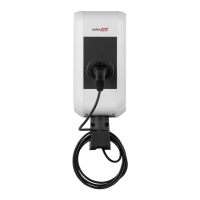EV ChargerSystem overview
Configuration manual V1.00
10
© SolarEdge Technologies
2.1.1 LAN
SolarEdge Home EV Charger can be connected to a router via the inte-
grated LAN interface. The router establishes a connection to an OCPP back-
end via internet.
1 ... SolarEdge Home EV Charger 2 ... Router
3 ... Internet 4 ... OCPP backend
Connection: Ethernet1 connection (LSA+
®
)
Via the LAN interface, SolarEdge Home EV Charger can also be connected
to other charging stations, allowing to implement a charging network.
Information
The Ethernet1 connector X4 (LSA+
®
) and the Ethernet2 connector X3
(RJ45) are connected in parallel on the PCB and cannot be used at the
same time. The unused connection must be disconnected if necessary (e.g.
during servicing).
The Ethernet1 connection X4 is designed as a terminal block in LSA+
®
tech-
nology. It is recommended to implement hard-wired communication (e.g. for
SmartHome or a charging network) at the LSA+
®
connection.
2.1.2 WLAN (optional)
SolarEdge Home EV Charger can be connected to a router via the inte-
grated WLAN interface. If the router is connected to the Internet, a connec-
tion to an OCPP backend can be made.

